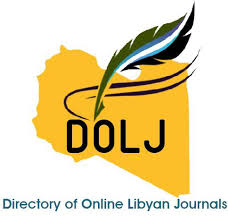Barriers for early detection of breast cancer in Libyan women in Tripoli
DOI:
https://doi.org/10.54361/Keywords:
women, breast cancer screening, demographic characteristic, LibyaAbstract
The present study was conducted to realize the most common barriers for breast cancer screening among Libyan women living inside Tripoli, the capital of Libya. A descriptive study was conducted at different places, during the period November, 2008 to July, 2009. A total of 221 women, aged 34 years and above with absence of former or current history of breast cancer, were participated in the study and completed self-administered questionnaire that assessed screening knowledge and related beliefs. The parameters computed were socio-demographic characteristics that include; age, education level, monthly income, marital states, previous breast cancer screening, family history of breast cancer, age of first menstrual period and the use of contraceptive. These demographic characteristic were statistically cross-matched with mean barriers scores. The mean age was 45.13 years and majority of women were married. The barriers to breast cancer were significantly higher among women who described a low annual household income family, women who did not know how to do self-examination and among women who listed never doing previous breast screening. While, there were no differences regarding to age, marital state and time of menarche. The four strongest barriers described by women were; there are no insurance coverage, have to wait too long, no way to get there and fear of mastectomy. This study indicates that the effective approach to reduce mortality associated with breast cancer is the early screening since its etiology remains uncertain. Moreover, to increase the awareness of women to the importance of breast screening there is a great need for a well-organized health educational program and improvement of each family economic situation. The better understandings of barriers to breast screening lead to improve interventions directed at reduce morbidity and mortality among women.
Downloads
References
Sadler GR, Ko CM, Cohn JA, White M, Weldon RN and Wu P. Breast cancer knowledge, attitudes, and screening behaviors among African American women: the Black cosmetologists promoting health program. BMC Public Health. 2007, 7, 57.
Bray F, McCarron P and Parkin DM. The changing global patterns of female breast cancer incidence and mortality. Breast Cancer Res. 2004, 6: 229-239.
Todd A and Stuifbergen A. Breast cancer screening barriers and disability. Rehabil Nurs. 2012, 37, 74-79.
Saslow D, Boetes C, Burke W, Harms S, Leach MO, Lehman CD, Morris E, Pisano E, Schnall M, Sener S et al. American Cancer Society guidelines for breast screening with MRI as an adjunct to mammography. CA Cancer J Clin. 2007, 57: 75-89.
Azaiza F and Cohen M. Health beliefs and rates of breast cancer screening among Arab women. J Womens Health (Larchmt). 2006, 15: 520-530.
Donnelly TT, Khater AH, Al-Bader SB, Al Kuwari MG, Al-Meer N, Malik M, Singh R. and Jong FC. Arab women's breast cancer screening practices: a literature review. Asian Pac J Cancer Prev. 2013, 14: 4519-4528.
Kawar LN. Knowledge about breast cancer and negative influences affecting breast cancer screening among women in Jordan. International Journal of Humanities and Social Science. 2012, 2, 18: 1-11.
Miller AB. Screening for breast cancer in the Eastern Mediterranean Region. East Mediterr Health J. 2010, 16: 1022-1024.
El Mistiri M, Verdecchia A, Rashid I, El Sahli N, El Mangush M and Federico M. Cancer incidence in eastern Libya: the first report from the Benghazi Cancer Registry, 2003. Int J Cancer. 2007, 120, 392-397.
Boder JM. Elmabrouk Abdalla FB, Elfageih MA, Abusaa A, Buhmeida A and Collan Y. Breast cancer patients in Libya: Comparison with European and central African patients. Oncol Lett. 2011, 2: 323-330.
Cohen M and Azaiza F. Increasing breast examinations among arab women using a tailored culture-based intervention. Behav Med. 2010, 36: 92-99.
Sadler GR, Dhanjal SK, Shah NB, Shah RB, Ko C, Anghel M and Harshburger R. Asian Indian women: knowledge, attitudes and behaviors toward breast cancer early detection. Public Health Nurs. 2001, 18: 357-363.
Dameh T and Kofahi S. Barriers to breast cancer screening among women in the north of Jordan. JMJ. 2008, 3: 186-190.
Austin LT, Ahmad F, McNally M J and Stewart DE. Breast and cervical cancer screening in Hispanic women: a literature review using the health belief model. Womens Health Issues. 2002, 12: 122-128.
Lamyian M, Hydarnia A, Ahmadi F, Faghihzadeh S and Aguilar-Vafaie ME. Barriers to and factors facilitating breast cancer screening among Iranian women: a qualitative study. East Mediterr Health J. 2007, 13: 1160-1169.
Kawar LN. Barriers to breast cancer screening participation among Jordanian and Palestinian American women. Eur J Oncol Nurs. 2013, 17: 88-94.
Sabatino SA, Coates RJ, Uhler RJ, Breen N, Tangka F and Shaw KM. Disparities in mammography use among US women aged 40-64 years, by race, ethnicity, income, and health insurance status, 1993 and 2005. Med Care. 2008, 46: 692-700.
Banning M and Hafeez H. Perceptions of breast health practices in Pakistani Muslim women. Asian Pac J Cancer Prev. 2009, 10: 841-847.
Downloads
Published
Issue
Section
License
Copyright (c) 2014 Yousef A. Taher, Awatef M. Samud, Eman A. AlGhani, Eman D. Enemni (Author)

This work is licensed under a Creative Commons Attribution-NonCommercial-NoDerivatives 4.0 International License.
Open Access Policy
Libyan journal of medical Research (LJMR).is an open journal, therefore there are no fees required for downloading any publication from the journal website by authors, readers, and institution.
The journal applies the license of CC BY (a Creative Commons Attribution 4.0 International license). This license allows authors to keep ownership f the copyright of their papers. But this license permits any user to download , print out, extract, reuse, archive, and distribute the article, so long as appropriate credit is given to the authors and the source of the work.
The license ensures that the article will be available as widely as possible and that the article can be included in any scientific archive.
Editorial Policy
The publication of an article in a peer reviewed journal is an essential model for Libyan journal of medical Research (LJMR). It is necessary to agree upon standards of expected ethical behavior for all parties involved in the act of publishing: the author, the journal editorial, the peer reviewer and the publisher.
Any manuscript or substantial parts of it, submitted to the journal must not be under consideration by any other journal. In general, the manuscript should not have already been published in any journal or other citable form, although it may have been deposited on a preprint server. Authors are required to ensure that no material submitted as part of a manuscript infringes existing copyrights, or the rights of a third party.
Authorship Policy
The manuscript authorship should be limited to those who have made a significant contribution and intellectual input to the research submitted to the journal, including design, performance, interpretation of the reported study, and writing the manuscript. All those who have made significant contributions should be listed as co-authors.
Others who have participated in certain substantive aspects of the manuscript but without intellectual input should only be recognized in the acknowledgements section of the manuscript. Also, one of the authors should be selected as the corresponding author to communicate with the journal and approve the final version of the manuscript for publication in the LJMR.
Peer-review Policy
- All the manuscripts submitted to LJMR will be subjected to the double-blinded peer-review process;
- The manuscript will be reviewed by two suitable experts in the respective subject area.
- Reports of all the reviewers will be considered while deciding on acceptance/revision or rejection of a manuscript.
- Editor-In-Chief will make the final decision, based on the reviewer’s comments.
- Editor-In-Chief can ask one or more advisory board members for their suggestions upon a manuscript, before making the final decision.
- Associate editor and review editors provide administrative support to maintain the integrity of the peer-review process.
- In case, authors challenge the editor’s negative decision with suitable arguments, the manuscript can be sent to one more reviewer and the final decision will be made based upon his recommendations.















